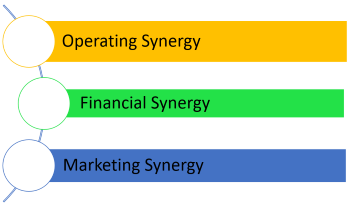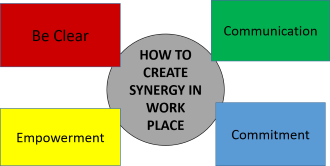There is no “I” in a team it is always “we” in the team, this is synergy. Synergy combines two or more components where the combined effort is greater than the performance of each component alone. When two people start working at a new level because of the support and cooperation they share, there is a partnership. Even if a team does not have bright people, they can still work as a team to achieve more than their abilities. It helps in increasing employee dedication towards the company and success and identifies the strength of each member of the team.
With synergy, it is easier to increase the motivation and satisfaction of employees. It promotes co-operation between managers and employees and themselves too. It is commonly used in mergers and acquisitions, franchises, joint ventures, etc.
Shareholders often benefit from the partnership, as the post-alliance share price often increases and creates multi-sectoral working groups to increase productivity and quality. Synergy can be achieved with features such as integrated talent, integrated technology, and systematic processes that allow for cost reduction and additional revenue.
BUSINESS SYNERGIES

OPERATING SYNERGY
When the combined value of two firms is greater than the total number of separate firms when the combined firm allows firms to increase their operating revenue and achieve higher growth it is called Operating synergy.
It can arise from a scaled economy, high pricing power, and high rates resulting from a large market share and low competition, a combination of different working capabilities such as marketing skills and a good product line, or high growth rates from new and expanded markets. Operation synergies achieved through integration, acquisition, or acquisition of skilled firms in various fields such as production, research, and development, or marketing and finance can also help to achieve operational success. Tata Steel one of the largest steel companies in India; took over Corus which was Europe’s second-largest steel company in 2007. The acquisition was intended to give Tata metal access to European markets and to facilitate potential collaborations in the fields of manufacturing, procurement, R&D, logistics, and office operations.
FINANCIAL SYNERGY
Financial synergy is often considered in mergers and acquisitions, but recent strategic alliances include strategic partnerships. These synergies are related to developing financial metrics for a combined business such as income, debt volume, capital costs, profits, etc. Examples of it include increased revenue on a large customer basis, lower costs through organised operations, talent, and technological harmony.
Besides the above, it can lead to these benefits after acquisition: higher cash flows, lower capital costs, tax benefits, etc. Renault-Nissan strategic partnership or automotive cooperative expects to generate 5.5 billion euros ($ 6 billion) by 2018 by combining more diversification and better resource sharing between partnerships. The two companies are working together to reduce costs.
MARKETING SYNERGY
Marketing synergy means that the combination of marketing mix makes the overall performance work. For example, by taking hold of an opportunity that makes it possible to maximise the use of existing marketing and distribution facilities, it is possible to improve sales revenue without causing cost overruns. Hero Honda Ltd was a joint venture between Hero Cycles of India and Honda Motor of Japan. The long-standing Hero Cycle experience on Indian road conditions including Indian and urban customers is integrated with Honda Motor’s high technical capabilities to create the expected impact of producing fuel-efficient and robust cycles to meet the specific needs of Indian customers and meet the bad road conditions since 1985. The partnership lasted 26 years.
BENEFITS OF SYNERGY
- Fulfils the organisation’s vision and mission
- It produces better solutions to problems
- It helps to avoid conflicts of interest.
- It helps to retain staff and customers and speed up product development
- Increase organisational outcomes – high level of employee ethics and job satisfaction, high profitability, etc.
- Creates better results.
Be Clear – For a team to work well together, everyone in the team needs to know the goal, and everyone’s goal needs to be the same. Different team members will be performing different tasks to achieve that goal, but different objectives create chaos and conflict. The same goes for unclear goals. Goals need to be defined so each person understands what success looks like and is intended to help achieve it.
Commitment- The team needs to communicate so that each player knows what their teammates need from them. Naturally, most communication takes place in the planning stages. The key is finding a balance between direct and respectful. Be specific about your needs or instructions (as clear terms are best). Know the burden or pressure you place on them and do all you can to make their progressive obligations come true.
Empowerment – The level at which a person gives encouragement, tools, and authority to others, enabling them to use their strengths, skills, and abilities effectively. A coach trains his team well and instills in each player the belief he or she can accomplish the task at hand. Players know that team success is more important than the success of any individual player, so they help each other, and they trust their teammates to do the same. Showing your team you trust their skills and that you trust them to do their job well is the most important task a team leader has.
Communicate- Team members require a personal commitment to the overall success of the team. This has a lot to do with empowerment because a team cannot function well if no one trusts their teammates to get back on track. Success requires dedication and commitment goes hand in hand with dedication. Different behaviours, skills, and interests pose a risk of creating conflict within the team, which can confuse purpose and unclear communication. Creating team synergy is difficult, but if you are committed to the team, others will follow soon.



